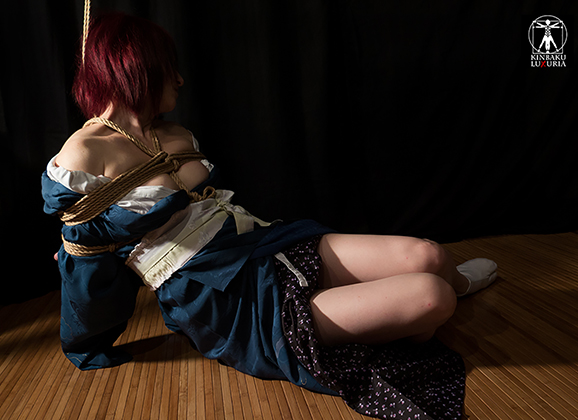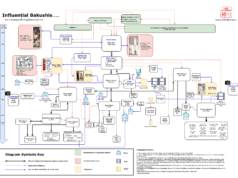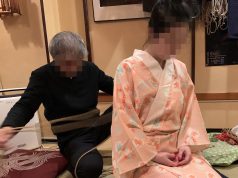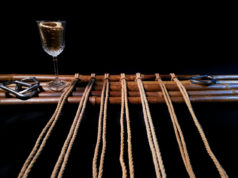[This article first appeared on Kinbaku Today in Jan 12, 2015. Since then it has been substantially revised and is new being republished. -Ed]
Quite often models ask me how do I deal with pain.
First of all, let me remind that our Semenawa favours the experimentation of suffering, not pain.
I’m not a masochist. Never been.
Outside a session in which I feel submitted, I hardly can manage painful stimuli.
So what are the tools, the techniques, I personally use to deal with the painful sensations, with progressive suffering, and to turn them into something I can space for?
1. Breathing
When I know I am going to experience something challenging I close my eyes and start slowing down and regulating the rhythm of my breathing.
When you slow down the breathing, you actually slow down your heartbeat and this immediately puts you in a space where you are more relaxed.
I breathe slow and deep, when possible, slow and extended, when my breathing capacity is limited from the tie. I breathe with different parts of my body when I cannot expand my lungs, for example with my belly only. Or very shallow and superficial like when you want to steam a glass. Breathing has an immediate natural effect on the perception of pain, helps me relaxing, detaching, and getting rid of negative feelings.
One of the main mistake we do in stressful situations is hyperventilating. And this puts you actually in a fighting mode. Riggers can notice that, come close and help us to breathe slowly. My rigger for example puts very often a hand on my chest or my neck if he notices some changes on my breathing pace, he breathes with me and models my breathing with his own pace.
Breathing is imposing a different timing to your fight and reactive mode and allows you to give time to time and trust the ropes will have their effect. Do you remember the movie Kill Bill, when Uma Thurman (Beatrix Kiddo) wakes up in a coffin and realizes she’s buried alive? First she panicked. Then she realized the only way to go out and try to survive was slowing down her breathing, saving energies and be focused.
2. Surrendering
For me ropes are a Ds activity. It’s one of the very few situations in which I can really let go completely control. In my day life I am always in control. I am a control freak. I teach adults and need to be strong and authoritarian sometimes.
Submitting and letting go doesn’t simply happen. It’s a decision. You have to learn how to do it, step by step like for every activity that is new for you.
A very good way for me to learn to do this is to reach an edge and resist more than I could imagine in that edge. Like when you’re running and you’re tired and destroyed and you think you cannot go on other 100 meters. If you let yourself push further just a little that limit, you will probably run another km without realizing!
I see sometimes models stopping the feeling even before experiencing it.
You think it’s going to be hard, so you already prevent your capability to adapt. Instead I think we need to go there. We need to stay there and accept there is “no escape”. We adapt to everything. We just need to give ourselves the time to sink in the discomfort.
This is the reason why I do not fight and resist to the discomfort: I follow it.
As the moment my brain and my body let go, the bliss begins.
When I can sink in a tie, even hard, and avoid contracting, this immediately helps me relaxing. It’s like “accepting death”. Again, if we have a way out, usually our brain tries to fight any form of discomfort. While if we know that we NEED to adapt to the new situation, for survival need both our brain and body will find a way to deal with it.
Riggers too have a role in this. If they untie us as soon as we make a sound of discomfort of course they do not help us. Of course I am not talking of situations where there is a real risk/accident going on. But if Riggers panic too and create immediately a quick escape for the model, they’re actually not helping us to “process”. While being assertive and helping us experiencing that feeling could be actually more appropriate.
A personal trainer in the gym will not allow you to let go when you are doing your abs. He will probably encourage you to keep it until the end… and then celebrate you in the end because you did a great job!
3. Offering
I let my brain focus on the fact that the suffering I am living is an offer to my Rigger at that moment. I love managing, as I live that act like an offer to him. I give him the time to admire me in suffering. I love to feel beautiful for him, it’s a sweet sacrifice.
I know my rigger likes to see me suffering beautifully. It’s like when you go to a party and you want to look beautiful. You resist the discomfort of high heels because you know you’re going to be super cool! When he comes close to me and tells me that I’m looking beautiful, that is the prize for me. We are more ready to accept a little sacrifice in order to feel that great and be admired.
4. Sensory splitting
I found I apply this quite often. It’s a technique that involves dividing the sensation (pain, burning, pins and needles) into separate parts. For example, when a shoulder is in pain for a hard Takate Kote, and this kind of feeling is identifiable as “hot”, I just focus just on the sensation of the heat and not on the hurting.
Not only: you can actively decide to focus on another part of your body aching (and preferably, a minor pain), so to force your brain not to “listen” to the major source of pain. In order to do this, you can even proactively apply pressure in an other specific area of our body to address the attention of our brain in that direction. (for example, my shinbone is aching like crazy for a Futomomo tie, I decide to press with all my weight on the waist-line).
5. Mental analgesia
This is really nice. It works like that: you have to imagine a strong pain killer drug, like morphine, entering into the painful area. What I personally do, is imagining my brain while producing endorphins. As I know that this is happening, and that those endorphins are having effect in a short time, I just wait for them to flow.
But, first of all. Ask yourself WHY you’re feeling what you’re feeling. Sometimes our reactions in ropes during a session are not actually pain, or not necessarily negative. Many of our reactions in fact depend from fear: we could be scared of getting harmed, or we are experiencing something completely new, our body is not used to that, so the hyper-reaction we have could be determined by this condition.
We always have to ask ourselves honestly if our reaction is due to actual pain or fear, and we need to learn how to distinguish “painful” from “harmful”.
The main fear responses we have are usually two: fight-or-flight response, this means confronting/facing the fear or trying to escape/avoid. In extreme cases, that fear can transform into a freeze response or paralysis. This feeling can distort completely our perception of reality and deeply impact our brain and body reactions.
So stopping for a minute, analyzing what is happening, breathing, relaxing and focusing, can be a good process to help us clear our mind to better understand what we are really feeling.
(You can read for further reference this list of techniques used to control chronic pain: http://www.spine-health.com/conditions/chronic-pain/11-chronic-pain-control-techniques)







